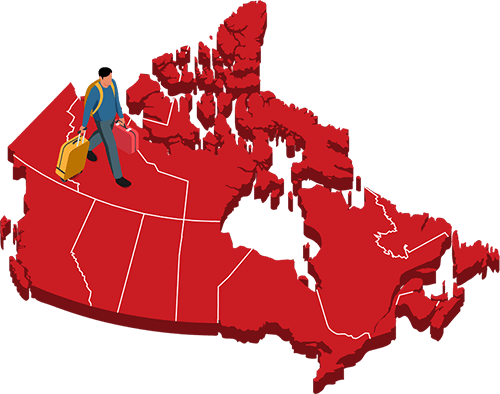STUDY IN USA

Get in Touch
Study in USA
Studying in the United States is a dream for many students worldwide. With its prestigious universities, diverse cultures, and unparalleled opportunities, the USA is a top destination for students looking to enhance their education and career prospects.
Benefits of studying in the USA:
1.High-quality education
The USA has some of the world’s best universities and colleges. Many of the top institutions in the USA are top-ranked worldwide. The education system in the USA is renowned for its academic excellence, state-of-the-art facilities, and innovative teaching methods.
2.Diverse Culture
Studying in the USA helps students explore a diverse and multicultural environment. Students can meet people from different backgrounds and learn about different cultures, making their academic experience more prosperous and fulfilling.
3.Career Opportunities
The USA is home to many leading companies and organizations, offering students numerous internship and job opportunities. Moreover, the USA is the global economic hub. Studying in the USA offers students the skills and knowledge necessary to succeed in their chosen fields.
4.Flexibility
The US education system is very flexible, allowing students to design their own course of study based on their interests and career goals. For this purpose, universities offer programs with major subjects (core subjects) and minor subjects (students’ other subjects related to their interest). Students can also transfer between universities and change their majors if they wish.
Admission process
1.Research
Start by researching the universities that offer the programs you are interested in. Check their admission requirements, application deadlines, IELTS or TOEFL requirements, and tuition fees.
2.Standardized Tests
Most universities require international students to take standardized tests such as the SAT, ACT, GRE, or GMAT. Check the university’s admission requirements to see which test(s) you must take.
3.Application
Once you have selected the universities you want to apply to, you must complete the application form and submit it with your academic transcripts, test scores, essays, and other supporting documents.
4.Visa
Once you have been accepted into a US university, you will need to apply for a student visa. The process can be time-consuming, so it’s essential to start early.
Tips for international students
Studying in the USA can be an exciting and challenging experience. Here are some tips for international students to make the most of their college experience:
1.Be open-minded.
Embrace the diversity and cultural differences in the US. It’s an opportunity to learn and grow as an individual.
2.Seek help
Get assistance from study abroad experts. Many resources are available on campus to assist international students, including academic advising, career counseling, and language support.
3.Get involved
Join clubs, organizations, and events on campus to meet new people and engage in extracurricular activities.
4.Budget carefully
Studying in the USA can be expensive, so budgeting is essential. Look for scholarships, grants, and part-time jobs to help cover your expenses.
Degrees Offered
In the USA, several degree types are offered by colleges and universities. The most common degree types are:
1.Associate D
Community colleges and technical schools generally offer associate degrees (AA or AS): This two-year degree program typically requires 60 credit hours of coursework. Community colleges and technical schools generally offer associate degrees and provide a foundation for further study or entry-level employment.
2.Bachelor’s Degree (BA or BS)
This four-year degree program typically requires 120 credit hours of coursework. Bachelor’s degrees are offered by colleges and universities and provide a broad-based education in a chosen field of study.
3.Master’s Degree (MA, MS, or MBA)
This graduate-level degree program typically requires one to two years of coursework beyond the bachelor’s degree. Master’s degrees are often specialized and provide advanced training in a specific field.
4.Doctoral Degree (PhD or EdD)
This is the highest level of education and typically requires three to six years of coursework beyond the master’s degree. Doctoral degrees are research-focused and provide in-depth study in a specific field.
5.Professional Degrees
These are specialized degrees in law, medicine, dentistry, and veterinary medicine. Professional degrees require several years of additional study beyond the bachelor’s, often including clinical training or internships.
Intakes in the USA Universities
1.Fall Intake
This is the most common intake in August or September. Most undergraduate and graduate programs start in the fall.
2.Spring Intake
This is January’s second most common intake. It is more common for graduate programs than undergraduate programs.
3.Summer Intake
Some universities have a summer intake, which usually starts in May or June. However, this intake is less common than the fall and spring intakes and is mostly for short-term programs or courses.
4.Rolling Admissions
Some universities have a rolling admissions policy, which means they accept applications throughout the year, and admissions decisions are made on a rolling basis as applications are received. Top universities It’s important to note that not all universities offer all intakes, and the availability of intakes may vary depending on the program and the university.
Additionally, some programs may only have one intake per year, so it’s essential to research the specific program and university you’re interested in to understand their intake options.
Best universities in the USA
There are many excellent universities in the USA, and the “best” university can vary depending on individual needs, interests, and career goals. However, here are some of the top-ranked universities in the United States, according to the 2022 U.S.
News & World Report Best Colleges rankings:
- Princeton University
- Harvard University
- Columbia University
- Massachusetts Institute of Technology (MIT)
- Yale University
- Stanford University
- University of Chicago
- California Institute of Technology (Caltech)
- University of Pennsylvania
- Duke University
Other notable top-ranked universities in the USA
- Johns Hopkins University
- Northwestern University
- University of Michigan-Ann Arbor
- University of California-Berkeley
- University of California-Los Angeles (UCLA).
Scholarships offered for international students
1.Fulbright Scholarships
These scholarships are funded by the U.S. government and are available to students worldwide who wish to study, conduct research or teach in the United States.
2.Hubert H. Humphrey Fellowship Program
This non-degree scholarship program is for experienced professionals who wish to take courses and participate in professional development activities in the U.S.
3.AAUW International Fellowships
The American Association of University Women offers fellowships for women who are not U.S. citizens or permanent residents and who are pursuing graduate or postgraduate studies in the United States.
4.Aga Khan Foundation International Scholarship Program
This program provides scholarships to outstanding students from developing countries who have no other means of financing their studies.
5.Rotary Peace Fellowship
This fellowship is for students who wish to pursue a master’s degree in peace and conflict resolution at one of six Rotary Peace Centers worldwide, including one in the United States..
6.Harvard University Scholarships
Harvard University offers scholarships to international students, including the Harvard International Student Financial Aid Application, based on financial need.
7.MIT Scholarships
The Massachusetts Institute of Technology offers a range of scholarships to international students, including the International Students Office Scholarship and the International Undergraduate Scholarship.
Post-study work permits
The post-study work permit in the United States is known as Optional Practical Training (OPT). OPT is a temporary employment authorization that allows international students who have completed a degree program in the United States to gain practical work experience in their field of study for up to 12 months.
In addition to the standard OPT, a STEM OPT extension allows students in specific STEM fields (science, technology, engineering, and mathematics) to extend their OPT for an additional 24 months, for 36 months.
To be eligible for OPT, students must have maintained valid F-1 student status and completed at least one academic year of full-time study in the United States. They must also apply for OPT through their school’s international student office and receive approval from the United States Citizenship and Immigration Services (USCIS).
While on OPT, students are allowed to work for any employer in their field of study, and they may also be self-employed or work as independent contractors. However, they must report their employment status and any changes in their employment to their school’s international student office.
It’s worth noting that OPT is a temporary employment authorization and does not guarantee permanent work or immigration status in the United States. However, many students use OPT as a stepping stone to other employment or immigration opportunities in the country.
Types of study visa in the USA
There are several types of study visas available for international students who want to study in the United States:
F-1 Visa: This is the most common student visa for academic programs. It is for students pursuing a full-time academic program at a college, university, conservatory, or other academic institution.
J-1 Visa: This visa is for students who want to participate in an exchange program, including academic study, research, or a training program. It is often used for cultural exchange programs and international education.
M-1 Visa: This visa is for students pursuing a vocational or technical program in the United States, such as a trade school or technical college.
Step-by-step process to obtain a study visa
1.Identify the type of student visa you need
There are two types of student visas in the USA, namely, F-1 visas and J-1 visas. An f-1 visa is for academic studies, and a J-1 visa is for exchange programs.
2.Choose the school or university where you want to study
Before applying for a student visa, you must be accepted into a school or university in the USA authorized by the US government to issue I-20 forms for an F-1 visa or DS-2019 forms for a J-1 visa.
3.Pay the SEVIS fees
Once you receive your I-20 or DS-2019, you must pay the SEVIS (Student and Exchange Visitor Information System) fee. You can pay the fee online on the official website of the Department of Homeland Security.
4.Complete the online visa application form
The next step is to complete the online visa application form (Form DS-160) on the website of the US embassy or consulate in your country. Schedule an appointment for an interview: After submitting the visa application form, you will need to schedule an appointment for an interview at the US embassy or consulate. The waiting time for an appointment may vary depending on the embassy or consulate.
5.Attend the visa interview
During the interview, you will be asked about your purpose of studying in the USA, your financial status, and your ties to your home country. You should bring all the necessary documents, including your passport, I-20 or DS-2019 form, SEVIS fee receipt, and proof of financial support.
6.Wait for the visa decision
After the interview, you will be notified about the decision on your visa application. If your visa is approved, you will receive your passport with the visa stamp. If your visa is denied, you can reapply after addressing the issues that led to the denial.
Take the first step!
Studying in the USA can be an excellent opportunity for international students to experience a diverse culture, access world-class educational institutions, and improve their language skills. The country boasts some of the most prestigious universities in the world, with a range of courses and degree programs available to suit different interests and career goals.
International students must also navigate visa requirements and cultural differences while adapting to a new environment. Nevertheless, studying in the USA can offer a unique and rewarding experience for those who are up to the challenge.
USA
Get in Touch
Just a few steps to get it started!







